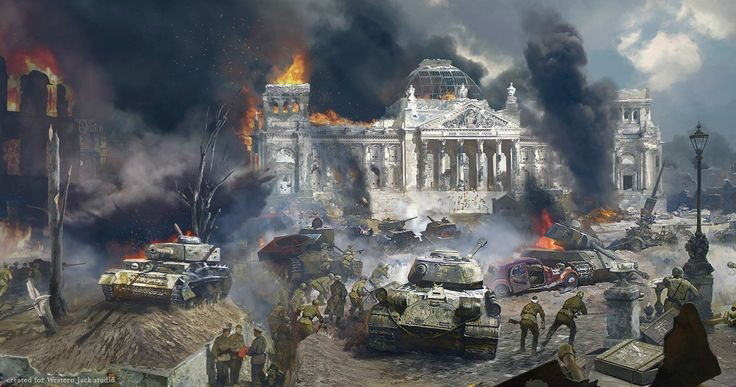Battle Of Berlin ( 1945 )
During the closing stages of World War II, from April 16 to May 2, 1945, the Battle of Berlin unfolded as a major offensive initiated by the Soviet Union against Nazi Germany, with the aim of capturing the German capital. This conflict involved multiple nations, with the Soviet Union serving as the primary aggressor and Germany defending Berlin. Here are some key details concerning the Battle of Berlin:
During the Battle of Berlin, the Reichstag, which is the German parliamentary building located in Berlin, played a significant role. The Reichstag was a strategic objective for both the Soviet Union and Nazi Germany due to its symbolic and strategic importance. Here are some key details regarding the Reichstag during the Battle of Berlin:
1. Capture and Defense:
- Soviet Objective: The Soviet forces aimed to capture the Reichstag as a symbol of their victory over Nazi Germany. It held immense historical and political significance.
- German Defense: The German forces, aware of the symbolic value of the Reichstag, fiercely defended the building, turning it into a strong defensive position.
2. Intense Fighting:
- Soviet Assault: The Soviet troops encountered heavy resistance from the defending German forces as they approached and attempted to capture the Reichstag.
- Street-to-Street Combat: The battle for the Reichstag involved intense street-to-street and building-to-building combat, with both sides engaged in fierce fighting.
3. Red Banner Over the Reichstag:
- Symbolic Moment: On May 2, 1945, Soviet soldiers raised the Soviet flag, adorned with the iconic red banner, atop the Reichstag, marking a significant symbolic victory and a symbol of the imminent defeat of Nazi Germany.
- Photograph: The image of the Soviet flag flying over the Reichstag became one of the most iconic photographs of World War II, symbolizing the triumph of the Soviet Union and the impending downfall of the Third Reich.
4. Significance:
- Psychological Impact: The capture of the Reichstag had a profound psychological impact on both the German and Soviet forces. It symbolized the imminent collapse of Nazi Germany and the triumph of the Soviet Union.
- Turning Point: The capture of the Reichstag was a decisive moment in the Battle of Berlin, signifying the final stages of the battle and the impending defeat of Nazi Germany.
Overall, the Reichstag's capture during the Battle of Berlin held great symbolic significance and marked a turning point in the battle, highlighting the impending collapse of Nazi Germany and the ultimate Soviet victory.
Participating Countries:
1. Soviet Union: Led by Marshal Georgy Zhukov, the Soviet forces constituted the primary attacking force, comprising millions of soldiers supported by tanks, artillery, and aircraft.
2. Nazi Germany: Germany, defending Berlin, was led by General Helmuth Weidling and consisted of various units from the German Army, Waffen-SS, and Hitler Youth. Despite their efforts, they faced severe numerical inferiority and lacked adequate supplies.
Prominent Officers:
- Soviet Union:
- Marshal Georgy Zhukov: Commander of the Soviet forces involved in the battle.
- Marshal Ivan Konev: Led the 1st Ukrainian Front, which formed part of the Soviet attacking force.
- Nazi Germany:
- General Helmuth Weidling: Commander responsible for the German defense in Berlin.
- Adolf Hitler: Dictator of Nazi Germany, though his involvement was limited due to his confinement within his bunker.
Weapons Employed:
Both sides employed a wide range of weaponry during the Battle of Berlin. Some notable examples include:
- Soviet Union: T-34 and IS-2 tanks, artillery, Katyusha rocket launchers, rifles, and submachine guns.
- Nazi Germany: Panzer tanks, including the formidable King Tiger (Tiger II), assault rifles like the StG 44, machine guns, and artillery. Additionally, various anti-tank weapons and the V-2 rocket were utilized.
King Tiger:
The King Tiger, also known as the Tiger II, served as a heavy tank employed by the German forces during World War II. Renowned for its thick armor and powerful 88mm gun, it was considered one of the most formidable tanks of its time. However, despite its deployment during the Battle of Berlin, the King Tiger did not significantly impact the battle's outcome due to the overwhelming numerical superiority and firepower of the Soviet forces.
Total Casualties:
The Battle of Berlin inflicted heavy casualties on both sides:
- Soviet Union: Estimates suggest that Soviet casualties ranged from 70,000 to 80,000 soldiers killed or wounded.
- Nazi Germany: German casualties, encompassing military personnel and civilians, were considerably higher. It is estimated that tens of thousands of German soldiers and civilians lost their lives during the battle.
Impact in Brief:
The Battle of Berlin marked the culmination of Nazi Germany's control over the capital and ultimately led to the collapse of the Third Reich. On April 30, 1945, Adolf Hitler committed suicide in his bunker beneath the city. Consequently, on May 2, 1945, German forces surrendered unconditionally. This significant event symbolized the ultimate defeat of Nazi Germany and heralded the imminent conclusion of World War II in Europe.
The Fire Went out Where it Started







Comments
Post a Comment